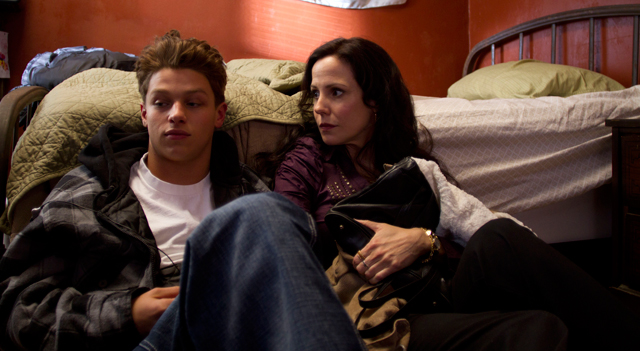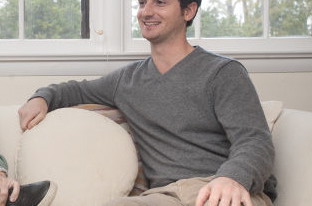 Back to selection
Back to selection
Scared Straight: Trevor White on Jamesy Boy
 Jamesy Boy
Jamesy Boy Ostensibly based on a true story, Trevor White’s Jamesy Boy recounts the ascension, demise and redemption of James Burns, a cavalier gang member whose story is an all too American one — he fell into a life of crime on the streets of Baltimore as a 14 year old, did some hard time, and was, somewhat astoundingly given the unrepentantly punitive nature of our disenfranchisement factories known as prisons, the better for it. He’s played by a promising newcomer, Spencer LoFranco, who is joined by an accomplished cast including Ving Rhames, Mary-Louise Parker and James Woods, in a somewhat surprising turn, as a tough-love warden.
White, a prolific short filmmaker making his feature debut, doesn’t shy away from the uglier aspects of a life of petty crime. While the picture’s somewhat oddly fractured chronology oscillates between Burns’ rise into gangdom and his years in jail following a long stint in juvenile detention, White’s touch with his veteran cast keeps material that initially seems familiar fresh enough to remain compelling. LoFranco and Woods’ scenes together are especially effective.
Jamesy Boy opened theatrically earlier this month, and it is released on Blu-Ray and DVD February 25th.

Filmmaker: Do you find inspiration in genre? The movie mixes several deftly.
White: It was never about trying to test my hand in a certain genre. It was always about, what is this story about to me? And to me it always was about redemption, about hope and how a kid who has always been labeled a loser breaks free of that label. In that sense, this is really a coming-of-age story for me. I thought there was something unique about telling a coming-of-age story in a world that was as bleak and cold as the streets of Baltimore and Pleasantville. For me it was never about trying to incorporate the genre elements but more, how can I maintain this coming of age feel while maintaining what this world truly is?
Filmmaker: American Hustle opens with a title card that says, “Most of this actually happened”, as if to suggest some of it didn’t. Did you feel a need to stick to the facts? Or were there places where you felt the need, because of the exigencies of drama, to embellish or to change the order of things or whatnot?
White: We definitely changed the order of things. We had to — there’s so many stories. When you put all the pain from James’ life up on a whiteboard, you figure out, how can I order this and how does this make sense so that it can be a story and a film with a driving force? We definitely took events and reordered them, but we always grounded it in the truth of what actually happened in James’ life. We tried to stay as true to that as possible. But like any filmmaker would tell you when they’re adapting a true story, you have to take some liberties at times.
Filmmaker: Can you talk a little bit about the packaging of the film? Did it take a long time? What were the key moments?
White: The whole process took a long time. Cast is going to play a critical role in the financing. And truthfully the financing plays a critical role in getting the cast. Actors want to know that this is a real movie and that they’re not wasting their time. And so you have that double-edged sword going the entire time. But we were really fortunate to have collaborators respond during the whole process of making this film, who really believed in it and championed it. I think a lot of people really held this idea of giving voice to a story that typically doesn’t get a voice, because it is not extraordinary. Thousands upon thousands of kids live a life like this.
We never really see their voices ourselves. And what does make James specifically unique and makes him extraordinary is the fact that he was able to kind of break free of it. You look at the statistics and he really is one of a kind given the cards that he’s been dealt. I think a lot of people really felt moved by that and when we started approaching these actors that was a huge selling point for them, knowing that they were a part of something that will possibly matter to a lot of people.
Filmmaker: Are you the type of director that purposefully deviates from your script? Or are you like John Sayles, for instance, in that what’s on the page is what needs to come out of the actor’s mouth? Also did you have the time because of the schedule to play around, or were there constraints that made it difficult to make this?
White: Time was hands down the biggest and most challenging aspect of making this film. There’s never enough time to really do what you want. A lot of the filmic process is about making compromises that you fall in love with along the way. We had 23 days to shoot the film. The challenge was that there were a lot of scenes in the film. We didn’t have a lot of two-, three-page dialogue scenes, which meant that there were a lot of moves and there were a lot of sets that had to be designed. All of that re-lighting is really what took up time. My style of directing is to be as prepared as humanly possible for the day, down to the shot list and to how you think you want the scene to unfold. I am completely willing to discover new ways of approaching it on the day, in the moment. There were multiple times that we would go through a scene and it would unfold exactly the way it was planned and other times we would get to the set and look at the first shots and someone would have a new idea of how to do it and we would change the blocking and the way the scene unfolded. That’s really exciting. I like to do a take or two how I’ve always envisioned it and how it was imagined in the script and then let the actors run with whatever ideas are kicking around their heads. More often than not, their ideas are way better than anything I have. I was really fortunate to work with a cast of this caliber, because they just elevated the material.
Filmmaker: Did you have any particular references for how you wanted the movie to look visually? And what was the process like of designing the feel and texture of the movie with your d.p.?
White: We had some visual references, but nothing that quite perfectly captured it. We look at movies like 8 Mile, Gran Torino as those gray, those muted tones. But something about those films felt colder on the whole than what we were looking for. We wanted to be able to capture that, yet at the same time have a certain level of warmth in the image, and in the colors, and in the design. That’s what really dictated the overall aesthetic of the film. Those are bleak environments no matter how you dress them, certain parts of Detroit and Baltimore. So I thought, if we can offer a little bit of warmth here and there, we can capture the hope of what the film is trying to portray.
Filmmaker: Often I find that movies are written as much in the editing room as in the preproduction and in the initial idea. I’m curious how the movie changed once you got into post. Whether there were things that you felt iffy about while you were shooting, but they turned out to be golden moments or vice versa. Things that maybe you felt were working really well on the set, but once you got into the edit, discovered you would have to change your conception of it.
White: You always make new discoveries in the edit room. It gives you a chance to be a storyteller all over again. We hired a guy named Josh Noyes to edit the film, who had done a film called The Wackness with Jon Levine, as well as his previous film, All the Boys Love Mandy Lane. Josh has an enormous amount of style and he’s not afraid to come up with new ideas. Given the way I shoot a scene, it’s very specific coverage he has to work with. The storyboards move in a certain way — I had it very mapped out in my head how it was going to be cut. What I loved about having Josh was that more often than not he was going to break free of what I had envisioned.
50% of the time I’d want to probably move back to the way I had envisioned it and the other half of the time he made it so much better than anything I could’ve imagined. That’s what would be the excitement of working with a guy like Josh — there’s no shortage of creative ideas in telling the story and working with certain scenes. Certain things got reordered and certain things changed from how we conceived them initially, I hope all for the better. Having the dual structure to the film, frequently we changed when we would go from one side of the story to the other.
Filmmaker: It was written that way initially, with the fractured style?
White: It was written that way. The two stories kind of have reverse arcs. We looked at telling the story laterally and it just didn’t work for us. We always thought there was something unique and interesting about seeing these two chapters in James’ life where. So we had these two reverse arcs that were kind of coinciding. There’s always worry involved in it. That’s tricky too to swallow as you make the film.
Filmmaker: Reflecting on the experience now, is there one principal thing you learned from making the movie about making movies in a broader sense that you hope to carry forward into your other work?
White: That’s such a tough question. I think that the whole process was just one giant worrying process. I’m incredibly proud of the film. There’s always, looking back on it, times I’d say, I wish I had more time here and there. I think you’re always going to have these concerns when looking back on your work. I think the big thing for me was, I was so concerned with capturing what was on paper and elevating it that I didn’t think in terms of the timetable we had while were shooting. I didn’t think as much about how much time I wanted to allocate to this scene versus that scene and as a consequence a couple scenes that were cut from the film we unfortunately spent hours and hours shooting. I wish I had the foresight to say, okay, this scene is not going to be that crucial. I should’ve spent that time elsewhere. So those are kind of the big things I’m going to be looking out for next time around.
